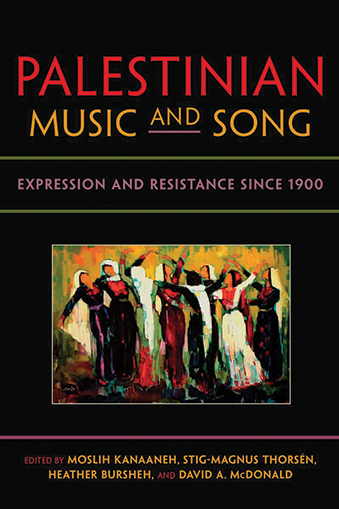Edited By: Moslih Kanaaneh, Stig-Magnus Thorsen, Heather Bursheh, and David A. McDonald
Indiana University Press, 2013, 215 pages, $40
Reviewed by: Ravenel Khashram, The American Colony Bookshop – Jerusalem
Palestinian Music and Song: Expression and Resistance Since 1900 is a compilation of essays and interviews addressing the evolution of Palestinian music from 1900 to the present and its role in political development.
Music transcends time, space, and societal gaps, making it the ideal tool for cultural and political development. Both colonizers and the colonized utilize music, albeit in different ways – the colonizers celebrate their triumphs, while the colonized express hope and retain identity. This is particularly true in the Palestinian context, as Palestinians continue to express hope for future generations
Prior to the Nakba, the cultural scene was vibrant and music was an important means of entertainment. Mothers sang lullabies to their babies, children sang songs in play, and adults sang while working. Competitions and festivals were held in cities and rural areas alike, and major artists, including Um Kulthoum and Mohammad Abd al-Wahab, performed in Palestine. Following the Nakba, and again after 1967, music evolved from being primarily entertainment to acting as an outlet for healing, expressing identity, and reaffirming patriotic ideals.
Throughout the 1960s and 1970s, musicians navigated politics, folk material, and the increasing influence of the West when composing and performing. The blending of Western music styles with traditional poetry and instruments essentially created a new genre to reinforce identity and celebrate Palestinian roots. Hip-hop infiltrated the Palestinian music scene beginning in the 1990s, allowing collaboration between Palestinians and Palestinian-Americans, and providing a connection for young diaspora Palestinians with their home. More recent music addresses the occupation and, more importantly, social issues within the Palestinian community.
The book concludes with a discussion of the use of music in Palestinian political movements. Prior to the First Intifada, the PLO used the arts as propaganda, attempting to foster unity within the competing factions under the banner of self-determination rather than religion or politics. The formation of Islamic political movements, specifically Hamas, led to the creation of music within an Islamic context. While the inherently religious messages of such parties differ greatly from those of secular Palestinian artists, the aspirations of spreading a political message and reinforcing identity remain the same.
Readers of this book will walk away with a greater understanding of Palestinian music and the role of the arts in reinforcing and expressing self. The editors’ decision to include essays that focus on the watersheds in Palestinian history allows readers to track the evolution of music while taking into account the catalysts affecting change.


